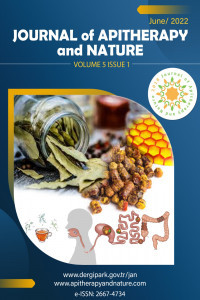Combination Treatment of Cuban Propolis and Nemorosone with Chemotherapeutic Agents Induce a Synergisitic Cytotoxic Effect in Drug-resistant Human Colon Carcinoma Cells
Combination Treatment of Cuban Propolis and Nemorosone with Chemotherapeutic Agents Induce a Synergisitic Cytotoxic Effect in Drug-resistant Human Colon Carcinoma Cells
Synergisitic Cytotoxic Effect, Cuban Propolis,
___
- 1. Oršolić N. A review of propolis antitumour action in vivo and in vitro. Journal of ApiProduct and ApiMedical Science. 2010; 2 (1):1 - 20.
- 2. Marcucci M. Propolis: chemical composition, biological properties and therapeutic activity. Apidologie. 1995;26:83-99.
- 3. Patel S. Emerging Adjuvant Therapy for Cancer: Propolis and its Constituents. Journal of dietary supplements. 2016;13(3):245
- Yayın Aralığı: Yılda 2 Sayı
- Başlangıç: 2018
- Yayıncı: Oktay YILDIZ
Fatty Acid Analysis and Biological Activity of Jordanian Propolis
Ashok K. SHAKYA, Shankar KATEKHAYE, Ghaleb A. ORIQUAT, Rajashri R. NAIK, Rajashri R. NAIK, Anant PARADKAR, Hugo FEARNLEY, James FEARNLEY
Yoga Bee, a New Approach for Health
Portuguese Propolis: A Source of Valuable Bioactivities
A CUNHA, H ALVES, C ARAÚJO, L BARROSO, M CRUZ, As FREİTAS, Aj GOMES, R GONÇALVES, R MARQUES, B MOREİRA, C PASSÃO, M PEİXOTO, H PEREİRA, R SİLVA-CARVALHO, İ VALENÇA, Am FERREİRA, F BALTAZAR, F PİNTO-RİBEİRO, S CARDOSO, R OLİVEİRA, C ALMEİDA-AGUİAR
Chemical Profile and Botanical Origin of Stingless Bee Propolis from Thailand and Indonesia
Cytotoxic Activity of Four Propolis Colombian Samples Against Canine Osteosarcoma Cells
Dolly Patricia Pardo MORA, Oscar Julián MURILLO, Mauricio Rey BUITRAGO, Mónica LOSADA, Jaime Fabian Cruz URIBE, Karina Basso SANTIAGO, Bruno José CONTI, José Maurício SFORCIN
North Aegean Greek Islands Propolis Antibacterial-Antifungal Activities against Malassezia
Konstantia GRAIKOU, Aristea VELEGRAKI, Mirto VARSANI, İoanna CHINOU
Effects of Propolis on the Quorum Sensing of Selected Biofilm Producing Bacterial Species
K. TENNICK, S. WAFA, H. FEARNLEY, M. GOMEZ ESCALADA
The Impact of Honeybee Origin on the Quality of Propolis
Gomes da Silva CAHANGO, Soraia I. FALCÃO, Miguel VILAS-BOAS
M. B. GABRIEL, M. J. CARNEIRO, A. C. H. F. SAWAYA
ARC (Apiceutical Research Centre): Developing a Global BeePharma Network Local Help for Local Health
